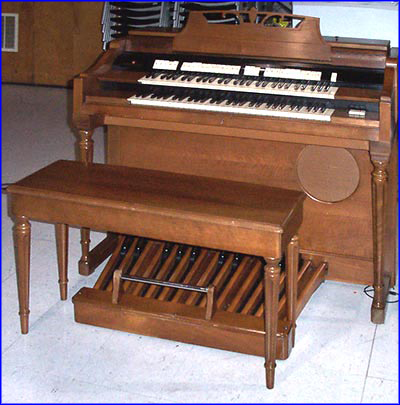Wurlitzer 4600 series
North Suburban HAMMOND ORGAN Service

A typical Wurlitzer 4600 series console. The almost identical 4602 is essentially the same instrument, but with slightly different vibrato circuitry and also the 4602 has 32 pedals
Here we're going to look at in some detail what is one of the more unusual electronic organs ever produced and marketed in fairly large quantities, the 1956 Wurlitzer electrostatic organ. In some ways these instruments were ahead of their time, and yet in other ways, they relied on a tone generation system that went back at least a hundred years if not further.
Actually, this instrument was a more modern and streamlined, technically advanced version of a line of instruments which had been manufactured at least two decades earlier, starting with an instrument known as the Everett Orgatron. If my chronology is correct, Wurlitzer took over the manufacture of the Everett Orgatron in the late 1930s, and for a while continued to market an instrument under their name that was essentially the same. But in the early 1950s, they radically redesigned the orgatron, simplifying it and also completely modifying the tone generation system so that the instrument became much more, to use a modern term, "user friendly" especially for the musicians who were to play it.
If any of you have ever encountered an early Everett Orgatron or Wurlitzer's first version of that instrument, you will probably recall it as having a rather limited array of tone colors, a very sluggish pedal bass where the tones would also drone on for a long time after you let up on any particular pedal, and where the console was also quite noisy. Initially these instruments were designed pretty much for the church market, but Wurlitzer quickly realized that they also needed to compete with Hammond and make an instrument which would be much more suitable for the general popular music market and especially private homes.
The end result of this was the vastly superior instrument which we describe here. At this point, they had several advanced features which Hammond did not have, such as variable note attack, pedal sustain, manual sustain independently available on two different groups of tone colors, and also percussive attack on the flute type tones. The variable attack and percussion sustain were optional and not all of these instruments included these features, however, from what I have seen, most of them did include them. Wurlitzer engineers also developed a fairly ingenious electronic vibrato circuit which would, like Hammond's vibrato, not only affect the instrument, but could be applied to any audio signals if you wanted to route that audio signal through the instrument's amplification circuitry.
Tonally, these 1950s Wurlitzer instruments were in a class by themselves. In many ways, they sounded a lot like small pipe organs, but they also had some tonal effects which defied imitation by any other means. Although unlike Hammond, they could not be guaranteed never to go out of tune, they were very pitch stable and could run for decades without needing any retuning. Instruments of this type which exist today are now between at least 70 years old. Of the ones I have seen, only one had a few of the very highest notes which were slightly out of tune, and even in that instrument, it was still close enough that tuning really was not necessary.
Unfortunately these instruments did not garner the same popular appeal that Hammond attained, and in 1961, Wurlitzer abandoned this design and started making instruments that used the newly developed tone generation circuitry that other makers were using. [solid state master oscillators for the top octave and frequency division for all lower pitches.] Nevertheless, there is still a limited but definite interest in these instruments and still people (myself included) who will repair and recondition them. When played through a good speaker system, they are quite impressive, and are very suited for playing all types of music from both the classical repertoire and also pop standards of the 20th century. This was especially true for those instruments which included the various percussion effects where, with a little understanding of how the instrument worked, you could get some nice guitar and banjo effects as well as different bell-like tones. Now let's see what the story is on the 1960s Wurlitzer Electrostatic Organs.
All of these Wurlitzer instruments utilize free reeds, whether keyed or continuously running. The Everett Orgatron models and also the early version of the Wurlitzer instruments contained electro-magnetically operated valves which controlled the operating air to each reed. The really significant improvement, and that which made these instruments practical and suitable for all types of music was the changeover to keying the voltage applied to the pickups over the reeds instead of keying the air supply. This of course meant that the reeds would run all the time, but that made them instantly available to generate signals as soon as the pickups received DC voltage from the various key and pedal contacts. The early models were of the "keyed reed" type whereas the later models were known as the "continuously running" reed instruments. In either case, all versions of the instruments used free reeds, and all versions of the instruments operated on the electrostatic or capacitive system to generate audio signals from the reeds. The actual acoustic sound of the reeds was never intended to be heard either as a supplement to, or in place of, the electrostatically generated audio signals although in the early, keyed reed models it could be heard. In the continuously running reed models, the soundproofing was much more elaborate.
Home Page Contents/Introduction. Begin Article